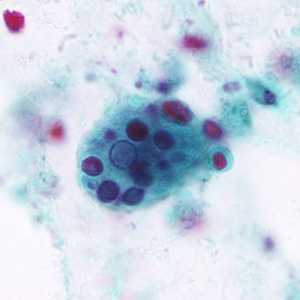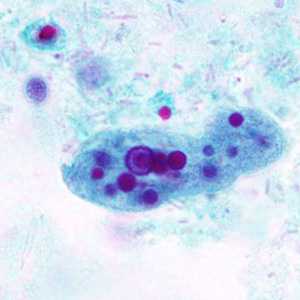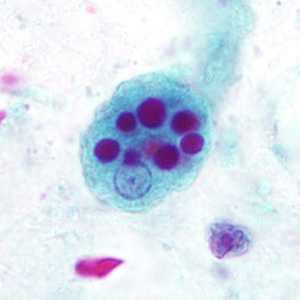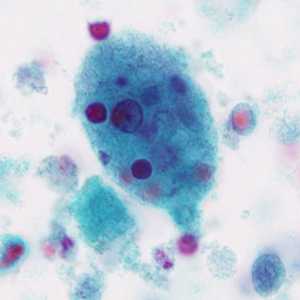
Case #296 - March, 2011
A 30-year-old man presented to his primary care provider with abdominal pain, fatigue, and diarrhea (sometimes tinged with blood). The patient had recently returned after two weeks in Armenia. A stool specimen was collected in both 10% formalin and poly-vinyl alcohol (PVA) for routine ova-and-parasite (O&P) examination. A smear was prepared from the PVA-preserved specimen and stained with trichrome. Figures A-D show what was observed in moderate numbers on the smear at 1000x magnification. The objects of interest measured on average 25 micrometers in length. What is your diagnosis? Based on what criteria?

Figure A

Figure B

Figure C

Figure D
Case Answer
This was a case of amebiasis caused by Entamoeba histolytica. Morphologic features shown included:
- trophozoites showing ingested red blood cells.
- nuclei showing evenly distributed peripheral chromatin and a centrally-located karyosome.
- some trophozoites showing progressive pseudopods.
If ingested red blood cells are observed, a species-level identification of E. histolytica may be given. Specimens presenting with these morphologic features, but without ingested RBCs, should be reported as E. histolytica/dispar and further testing such as PCR should be performed.
More on: Amebiasis
Images presented in the monthly case studies are from specimens submitted for diagnosis or archiving. On rare occasions, clinical histories given may be partly fictitious.
DPDx is an education resource designed for health professionals and laboratory scientists. For an overview including prevention and control visit www.cdc.gov/parasites/.
- Page last reviewed: August 24, 2016
- Page last updated: August 24, 2016
- Content source:
- Global Health – Division of Parasitic Diseases and Malaria
- Notice: Linking to a non-federal site does not constitute an endorsement by HHS, CDC or any of its employees of the sponsors or the information and products presented on the site.
- Maintained By:


 ShareCompartir
ShareCompartir